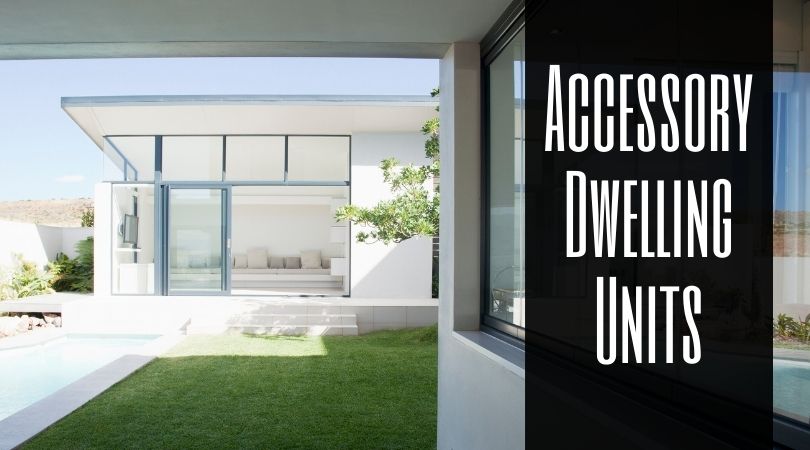What is an Accessory Dwelling Unit or ADU? Typically, ADUs are an improvement or addition to the home creating an independent living space. The Orange County Public Works Department describes ADUs as “attached or detached” unit that “provides complete independent living facilities” on the same lot or within the same structure as the main home.
Why Build An ADU?
There are many reasons why you might want to add an accessory dwelling unit to your home.

Some take the “mother-in-law apartment” literally, wanting to add living space for a relative that provides some independence and isn’t technically a cohabitation in the main home.
It’s a concept that still has strong appeal for those who want to offer living space to a friend or family member but you may also wish to consider adding an ADU to serve as a rental unit. The potential to earn a rental income is a powerful motivation to consider adding a separate living facility on your property.
But some mistakenly believe that adding an ADU will increase their property value significantly. It is true that in California some big city markets may value an ADU to the tune of up to 35% higher sale prices. But that does not necessarily translate into a good cost vs. investment calculation. Why?
In the Pacific region, Homelight.com estimates the cost-vs-value proposition for an accessory dwelling unit is a mere TWO PERCENT return on investment. Your motivation for adding an ADU may be well served if you need the space and/or want to rent. If you want to add one simply to increase your property value you may be exploring the wrong option.
What To Know About Accessory Dwelling Units In Orange County
Orange County real estate law includes certain guidelines about Accessory Dwelling Units. For example, did you know that such units may not be used, under O.C. rules, for short-term rentals like an Air b-n-b? That operation is not mentioned by name in these guidelines but it is easy to read between the lines.
Orange County Public Works rules say ADUs can only be rented out for 30 days or more. No “transient occupancy” type rentals (under 30 days) are permitted. Zoning is also an issue, an ADU is approved for property “zoned as residential use” which has existing construction or proposed construction status for a home.
ADU Rules In Orange County: Size
An ADU may be detached or built onto the existing structure of the primary residence. When the addition is a standalone and not attached to the main property, 1,200 square foot maximum within the “building site area” and an 800 square foot maximum “within the setback area where permitted” according to O.C. Public Works guidelines.
An attached ADU may be up to 50% of the main house with a maximum size of 1,200 square feet. There is also a provision in the rules for a “converted” ADU to allow for sizes up to the original size of the “converted structure” but generally must conform to the requirements listed above.
Comparables
When appraising a home, the appraiser compares it to the other houses like it in the housing market. Those houses are known as “comparables” and not having other homes to review makes it harder for the lender to approve a mortgage for a property that seems “nonconforming” or different than most of the other properties in the market.
Comparables in terms of appraisals and valuation are easier to find in today’s housing market thanks to the rising popularity of ADUs. In the past, if there weren’t many or any properties with comparable additions, the job of valuing the property and the improvements was much harder.
That made it harder to find a mortgage loan for homes with ADUs. More comparables in a housing market mean an easier time for the lender to justify approving a home loan for a property featuring an ADU.
Financing An ADU
The UC Berkeley Center For Community Innovation published a survey in 2021 that estimated the cost of adding an accessory dwelling unit at roughly $200 per square foot in Orange County.
That is the cost of the project only and does not take into account costs associated with permits or other behind-the-scenes details. Some borrowers may choose to fund the expense with a cash-out refinance loan or a home equity loan.
You may be able to apply for government-backed renovations loans like the FHA 203(k) Rehabilitation Mortgage (also available as a refinance) but you will need to discuss your project with the lender since only approved upgrades and improvements are permitted.
The FHA 203(k) loan, in particular, does not allow unrestricted cashback to the borrower; the projects must be approved in advance.
Financing an ADU With Credit Cards, HELOCs, Or Cash
Some may be tempted to finance such a project using a credit card, but it’s crucial to check interest rates and repayment terms, especially if you are applying for a credit card with a 0% interest introductory rate.
Will you be liable for the unpaid interest after that introductory period expires if you have not repaid the costs of the project in full before it expires? That is an important factor to consider when weighing your options.
The most efficient way to pay for an ADU is cash on hand, but at $200 a square foot that may be prohibitive for many. The key to determining which finance option is right for you? Compare interest rates, repayment periods, and above all any lender fees or other add-on costs to your financing.
Naturally, your financial needs dictate your funding options in a similar way to purchasing the original property itself. Is your priority to lower your out-of-pocket costs in favor of financing the project as fully as possible?
A lower interest rate will serve you well, which is why it may pay to compare HELOC, home equity loans, and credit card options. It would not serve your interests to pay for an ADU with a credit card cash advance since these typically feature higher interest rates and/or APRs than a regular credit card charge.
Home equity lines of credit make it possible to fund your project as you go rather than applying for a big loan all at once. However, unlike a credit card, both HELOCs and home equity loans use your house as the collateral for the loan.
If you fall behind on your payments on the credit card, you do not risk losing the property. If you fall behind on a HELOC or home equity loan, your overall investment could be in jeopardy.
Related Articles
| Orange County Cities | OC Mortgage Assistance Program (MAP) |
| Tips For Buying A House In Orange County | Garage Conversions & Granny Flats |

